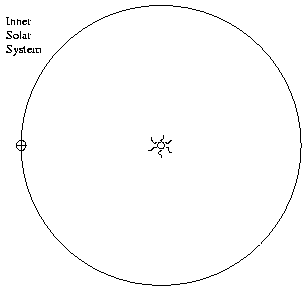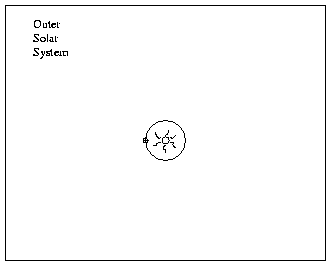 Copyright © Michael Richmond.
This work is licensed under a Creative Commons License.
Copyright © Michael Richmond.
This work is licensed under a Creative Commons License.
The Visible Planets
Humans in ancient cultures identified five planets in the sky:
Mercury, Venus, Mars, Jupiter and Saturn.
Together with the Moon and the Sun, these objects alone moved
relative to the stars.
Tonight, you can see ALL FIVE of these planets at once,
with your own eyes.
- Main task: place the six visible planets in their orbits
- Extra credit: attempt to measure Jupiter's period of rotation
Place six planets in their orbits
You will be given a sheet of paper, which has diagrams
of the solar system on each side.
Both diagrams show the Sun at the center, and the Earth
in its orbit around the Sun.
In one diagram, the Earth's orbit fills the page:
this will show the inner solar system.
In the other, the Earth's orbit is a tiny fraction of the page:
this will show the outer solar system.
(The diagrams below are just illustrations -- don't
use them for your work!)


The diagrams aren't very good yet ... but they will be when
you finish with them.
You will show the orbit of each of the five visible planets,
AND place a symbol showing the location of each planet in its
orbit tonight.
- Go outside, face west, and identify the five planets visible in
the sky.
- Measure the angular distance between each planet and the Sun.
(the instructor will tell you how far below the horizon
the Sun is)
- Look through the telescopes on the pad at Mercury and Venus.
- Draw a small picture of Mercury, and a small picture of Venus.
You will use the phase of each planet to determine its
location in its orbit.
- Go back inside the house.
- On the Inner Solar System diagram:
- draw circles representing the orbits of Venus and Mercury.
- place the symbols for these planets at the appropriate locations
for tonight.
Assume that the diagram shows the solar system, as viewed from
above (to the North of) the plane of the Solar System.
- calculate the distance to each planet. Show all work.
- On the Outer Solar System diagram
- draw circles representing the orbits of Mars, Jupiter and Saturn
- place the symbols for these planets at the appropriate locations
for tonight.
- calculate the distance to each planet. Show all work.
The Rotation Period of Jupiter
for extra credit, between lab meetings
We will attach a video camera to the 10-inch telescope tonight
and take pictures of the planet Jupiter.
We should acquire images over a span of about two hours.
I will save some of the best images and place copies
on the course web page.
Your job:
- Locate the images, and look at them carefully
- Try to identify a feature(s) in the atmosphere of Jupiter,
visible in pictures taken both early and late during the
class period
- Measure the motion of the features during the class period
- Express the motion in terms of degrees of circumference
- Calculate the rotation period of Jupiter. Show all work.
- Look up the rotation period of Jupiter. What is it?
- Compare your answer to the actual rotation period.
How close were you, in percentage terms?
Last modified by MWR 4/24/2002
 Copyright © Michael Richmond.
This work is licensed under a Creative Commons License.
Copyright © Michael Richmond.
This work is licensed under a Creative Commons License.


 Copyright © Michael Richmond.
This work is licensed under a Creative Commons License.
Copyright © Michael Richmond.
This work is licensed under a Creative Commons License.


 Copyright © Michael Richmond.
This work is licensed under a Creative Commons License.
Copyright © Michael Richmond.
This work is licensed under a Creative Commons License.